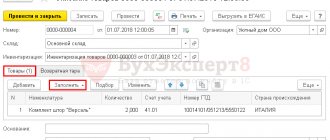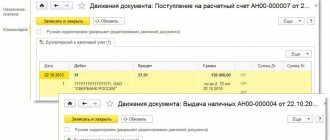Enterprises and organizations use the 55 account in cases where separate accounting of funds is required, both in national and foreign currency. Today’s topic is devoted to how the designated position in the Chart of Accounts works, what kind of correspondence may take place, and what standard accounting records are kept when carrying out such operations. At the same time, we will look at examples of accounting entries when using checkbooks, how credit and debit card payments are made, as well as transactions on deposit accounts in a financial institution.
Necessity and significance of position 55
This position is intended to provide synthesis of information on the availability and movement of financial resources on the territory of the Russian Federation and abroad, both in the currency of the Russian Federation and in banknotes of other states, with a letter of credit form of payment, the use of check books and other payment documents on current and other special accounts .
Analytics is carried out using separate sub-accounts opened for accounting:
- check books;
- foreign exchange transactions;
- settlements under letters of credit;
- deposits;
- other payments with the exception of bills of exchange.
The marked position is active. Its debit side reflects the funds accepted for accounting, and the credit side reflects their write-off.
In general, we can say that in accounting 55 position is used to reflect those transactions on bank accounts that differ in nature from settlement services, as well as transit, credit and loan accounts. In addition, it can also be used to account for company funds on electronic wallets.
Accounting for transactions on Account 55 “Special accounts in banks”
In accounting, there is another account for accounting for funds, this is account 55 “Special accounts in the bank”, on which accounting is kept:
55-1 “Letters of credit”;
55-2 “Checkbooks”;
55-3 “Deposit accounts”, etc.
A letter of credit is a special bank account in which funds can be reserved for settlements with a supplier. This is convenient for both the buyer and the seller. The seller will be confident that his goods or services will be paid for, and the buyer will know that he will be able to pay for the goods he purchased and will not incur a debt to the supplier. Each supplier has its own letter of credit. In accounting, letters of credit are recorded on account 55 “Special bank accounts”, on which subaccount 1 “Letters of credit” is opened.
There are these types of letters of credit:
· covered;
· uncovered.
Covered letter of credit , where money is debited from the buyer's checking account and deposited by the bank for subsequent payments to the supplier. In this case, accounting entry D55/1 K51.
The buyer cannot dispose of the funds contained in the covered letter of credit until the letter of credit expires. This is convenient if we are planning to make a purchase in the near future and want to reserve money for this so as not to spend it on something else.
When the letter of credit funds are transferred to the supplier, the following entry D60 K55/1 is reflected in the accounting records.
If the letter of credit is not used in full, then the balance is returned to the current account; this is documented by posting D51 K55/1.
For servicing a letter of credit, the bank charges a commission; in accounting, these expenses are written off to increase the cost of acquired material assets ( D08, 10, 41 K51 ) or taken into account in operating expenses ( D91/2 K51 ).
Postings when accounting for a covered letter of credit:
| Debit | Credit | Operation name |
| 55/1 | The required amount of money has been reserved | |
| 55/1 | Payment to the supplier from the funds of the letter of credit | |
| 55/1 | Unused letter of credit funds were returned | |
| 08, 10, 41, 91/2 | Bank commission withheld |
The second type of letter of credit is an uncovered letter of credit .
Uncovered letter of credit: the supplier's bank debits funds from the buyer's bank account for the amount of the open letter of credit. The buyer’s funds remain in circulation until the money is written off from the correspondent account of the servicing bank.
It is convenient because the money is in circulation and does not need to be frozen for some time.
If there is no money in the buyer's current account, the bank will withdraw it in parts as funds arrive.
When opening an uncovered letter of credit, it is recorded in off-balance sheet account 009 (D009). When the required amount is paid to the supplier, the accounting entry D60 K51 is made, and at the same time the same amount is written off from 009 (K009).
For servicing a letter of credit, the bank withholds a commission, which, as in the case of a covered letter of credit, is applied either to an increase in purchased values, or is taken into account as part of operating expenses.
Postings when accounting for an uncovered letter of credit:
| Debit | Credit | Operation name |
| Opened an uncovered letter of credit at the bank | ||
| Payment to the supplier | ||
| The paid amount is debited from the letter of credit | ||
| 08, 10, 41, 91/2 | Bank commission withheld |
Letters of credit are also revocable and irrevocable .
Revocable letters of credit : the buyer can cancel it at any time or change the terms without notifying the seller.
Irrevocable letters of credit : The buyer cannot change the terms of the letter of credit without the seller's approval.
Payments by checks.
Payments by checks are more common between legal entities; check books are also used when withdrawing cash from the organization itself from its current account.
A check is a security document containing an order to the bank to issue a certain amount of money to the person who presented the check for payment. Checks are strict reporting forms. Check books are accounted for in off-balance sheet account 006.
Checks are written off from account 006 as they are used.
To make payments using checks, you need to deposit the necessary funds into a special bank account. In accounting, account 55 is used for this, subaccount 2 - Check books. The posting when depositing funds intended for settlements by checks has the form - D55/2 K51.
After this, the received checkbook is debited to account 006.
When making payments using check books, the organization issues a check and certifies it with the necessary signatures and seal. After this, the check is transferred to the bank, which pays the bearer the amount of money indicated on the check. It is worth noting that the check is valid for 10 days, including the day it is issued. After using the check for the amount of funds paid, entry D60 K55/2 and the spent check K006 is immediately written off .
Unused checks are returned to the bank at the end of the year, and the balance of deposited funds is credited to the current account ( D51 K55/2 ).
In order for the bank to recognize the check as valid, it must be correctly filled out and contain all the necessary details specified in Art. 878 of the Civil Code of the Russian Federation.
How to fill out a check correctly:
The text in the check must necessarily contain the word “check”, an order to the bank to pay the required amount, in what currency the payment must be made, the name and payment details of the bank, the date of drawing up the check, the place of drawing up the check, and the signature of the authorized person.
Postings when accounting for settlements using checks:
| Debit | Credit | Operation name |
| 55/2 | Funds are reserved for check payments in a special bank account | |
| The received checkbook was capitalized | ||
| 55/2 | Cash issued by check | |
| Issued checks written off | ||
| 55/2 | The balances of the deposited funds from the checkbook were returned to the current account | |
| 08, 10, 41, 91/2 | Bank commission withheld |
2.5. Used deposit accounting
A deposit is the transfer of funds to a bank at interest.
Accounting for deposits is maintained on account 55, subaccount 3 “Deposits”.
The transfer of money to the deposit is reflected by posting D55/3 K51 . The interest received from the bank for the use of deposit funds is reflected in accounting by entry D76 K91/1 , then interest on the deposit is transferred to the current account, while the accounting entry is drawn up - D51 K76 . When closing the deposit, funds are transferred back to the current account, posting - D51 K55/3.
Postings for accounting of deposits:
Typical accounting entries
In practice, the following standard entries are used to reflect transactions on separate accounts:
1) Dt 55
Kt 50 – crediting cash to a special account at a credit institution;
2) Dt 55
Kt 51 – transfer of resources from current accounts to special accounts based on statements;
3) Dt 55
Kt 52 – placement of purchased foreign banknotes on deposit;
4) Dt 55
Kt 60 – return of funds to suppliers to special accounts;
5) Dt 55
Kt 62 – receipt of funds to the bank in a special account as part of the repayment of receivables;
6) Dt 52
Kt 55 – crediting funds from a special account to a foreign currency deposit;
7) Dt 60
Kt 55 – repayment of obligations to suppliers from a special account, etc.
Account 66 in accounting
Subaccounts of the account “Settlements for short-term loans and borrowings” are presented below in the figure:
This accounting account is passive, so its increase is reflected as a credit, and its decrease is recorded as a debit. In other words, the debit of the account reflects the repayment of loans and borrowings, and the credit reflects their receipt. The loan balance of account 66 shows the balance of the debt.
Analytical accounting for account 66 is carried out by type:
- Credits and borrowings (separate bills);
- Credit organizations, including those engaged in discounting (discounting) bills or other debt obligations;
- To other lenders who provided credit or loans (drawers).
The amounts of accrued interest are accounted for separately.
Settlements on transactions (discount) of bills of exchange with an organization within a group of interconnected companies, about the activities of which consolidated financial statements are formed, are carried out separately.
Accounting records from check books
To begin with, it should be noted that a checkbook is a document of strict accountability and is issued exclusively by the bank. This document must be filled out carefully, eliminating corrections and errors.
The check consists of a tear-off part and a spine. After filling it out, the spine remains in the book, and the tear-off part is transferred to the bank to receive funds.
The movement of financial resources when performing transactions using checkbooks is reflected in subaccount 55.2. Thus, when a checkbook is issued, a certain amount of funds is deposited, which is reflected in the following entry:
1) Dt 55.2
Kt 51, 52, 66.
Check book funds are debited from the account as checks issued by the organization are cleared by the bank, which is reflected in the following transaction:
1) Dt 76
Kt 55.2
If the checks were returned to the credit institution, the amounts for them are reflected in the following entry:
1) Dt 51 or 52
Kt 55.2.
Making payments by debit card
Let’s imagine that a debit card was issued for the director of an enterprise for making payments during business trips, and therefore funds in the amount of 42,700 rubles were transferred to a special bank account.
During the next business trip, a payment for hotel accommodation was made using the designated card for a total amount of 12,700 rubles.
After the head of the enterprise returned from a business trip and provided a report, the accounting service made the following entries:
1) Dt 55
Kt 51 – 42,700 rubles, transfer of funds to the corporate account of the enterprise;
2) Dt 71
Kt 55 – 12,700 rubles, accounting for advance funds issued;
3) Dt 26
Kt 71 – 12,700 rubles, covering living expenses at the expense of travel allowances.
Transactions with a covered letter of credit
Example
LLC "Galfind" and LLC "Demiurge" entered into an agreement for the supply of materials in the amount of 1,200,000 rubles. The terms of the contract assume that payment for the delivery of LLC Galfind is made using a covered letter of credit. For this purpose, Demiurge LLC opens a letter of credit in the bank in the amount of 1,200,000 rubles.
The delivery was carried out only in the amount of 1,000,000 rubles. The remaining funds were returned to the settlement account of Demiurge LLC.
For servicing the letter of credit, the bank charged a commission of 0.% of the letter of credit amount.
Postings
At Demiurge LLC:
| Dt | CT | Operation description | Sum | Document |
| 55.1 | The amount of funds for the covered letter of credit is reflected | 1200000 | Bank statement | |
| 10 | 60 | Materials accepted for accounting | 1000000 | TORG-12 |
| 60 | 55.1 | Funds transferred to pay for equipment | 1000000 | Payment order |
| The amount of bank commission is included in costs (1200000*0.05%) | 600 | Bank statement | ||
| 55.1 | The unused balance of the letter of credit was returned to the account | 200000 | Bank statement |
Transactions on deposit accounts
Let’s assume that a certain company placed a deposit in one of the banks in April 2022 under the following conditions:
- placement period – 9 months;
- deposit amount – 137,000 rubles;
- interest on deposit – 21% per annum.
The company's accountant made the following entries:
1) Dt 55.3
Kt 51 – 137,000 rubles, transfer of funds to a bank deposit;
2) Dt 76
Kt 91.1 – 21,578 rubles, interest income on deposit;
3) Dt 51
Kt 76 – 21,578 rubles, crediting accrued interest to the company’s account.








